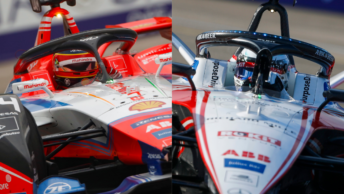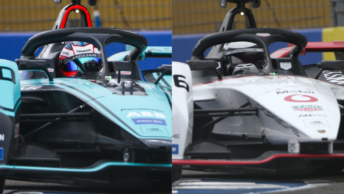Formula E is notorious for handing out penalties – which is a little unfair, most other motorsport actually hands out just as many but over, usually, a longer time period. The condensed schedule of a one-day event means that things come in a little more rapid-fire and well, FIA regulation language can be confusing at the best of times.
There were twenty stewards’ decisions yesterday – here’s a breakdown of what they all meant.
The longest decision ever
At least, in Formula E; Techeetah were fined €1,500 for having a member of staff without the correct pass work in their garage… in Marrakech, 158 days ago. The penalty was deferred to be issued by the stewards at their next meet, which at the time wasn’t scheduled to be in five months time but here we are.
Grid penalty boogaloo
Grid penalties for replacement parts are relatively rare in Formula E, compared to Formula One where you see teams tactically deciding to take colossal penalties to replace multiple power unit elements over a written-off weekend.
Formula E’s relatively compact calendar means that you can’t take a gamble with giving up a result unless you really have to, which with one one of each powertrain element permitted per season means teams don’t replace them unless it’s critical. And that the penalties can be really gruesome when you have to.
If the alternative is a DNS or a near-guaranteed DNF, though, it’s what a team has to do. We’ve seen a few this year – like the Mahindra cars both taking gear box replacement penalties in Mexico.
Oliver Rowland was the first car to face a 20-place grid drop, for replacing the inverter on his Nissan e.Dams. Without an inverter, the car won’t go (it’s what moves power in the battery to the drive train, so very critical) and if there’s a fault in it, you risk a miserable run of DNFs – as Di Grassi demonstrated at the start of Season 4 when one of his cars developed The Gremlins and wrote off the first half of the season.
The next driver to get whacked with grid penalties was James Calado, who wasn’t so much issued the decisions as submerged in them. At the start of FP1 Jaguar said that they were reviewing a small software issue on his car, which turned into a total powertrain replacement – no small job. Impressively, the team got Calado’s car out on track with 10 minutes in the session to spare, getting the full change done in about half an hour.
He reported ‘oscillations,’ however, which are very much not what you should feel your spinning MGU is doing and had to stop on track when the car’s red light activated, indicating a fault with the electrical systems and prompting a rubber-sheet retrieval by Formula E’s medical team. Following that, the team also had to replace the battery, earning Calado a massive 60 place total penalty as well as no FP2 running.
Rowland then joined him, after also replacing the gear box and earning a re-penalisation for the same offence.
In Formula E, if you cannot be moved back all the grid places you are set to be penalised then you receive a 10-second stop-go penalty, as well as starting from the back or even the pit lane. It’s rough but it discourages teams from going against the ethos of the championship and replacing parts.
Abuses of power
Formula E has strict regulations about how much overall energy you can use and at what power output. The maximum you’re allowed to send to the drive train at any time is 250kW and over-usage in a qualifying or race session will earn you a disqualification. However, in free practice – when Oliver Turvey got a wrist-slap for a mighty 258kW infringement, you just get to make a €1000 contribution to the FIA gala bar tab.
Energy is how much electricity you have, whereas power is how quickly you’re using it and both can get you in trouble if you go over them. It might sound a bit weird to say drivers can use more energy from the battery when it hits 0.0% but Formula E’s batteries have a 52kWh capacity for a race, which isn’t quite the full capacity of the cells.
So you can draw more power out of it after you hit 0.0% but you’ll be penalised for it with a disqualification, which happened to both Max Guenther and Sergio Sette Camara as cars crossed the line with nothing left to use.
Speeding
It might sound unintuitive to say there are restrictions on how fast you can drive a race car but there really are. Nyck de Vries got the wrong side of one for being too slow on his in (cool-down) lap after his 250kW Super Pole outing, earning him a €1000 fine.
Daniel Abt also received a 5-second time penalty for speeding under Full Course Yellow conditions (when drivers are required to slow down due to an obstacle on or issue with the track, for safety reasons)
Roughhousing
After a very clean race only one car was penalised for a collision. Venturi’s Edoardo Mortara hit Max Guenther, sending him into Mitch Evans and spinning the second-placed championship contender out of the points, earning Mortara a converted penalty of 18 seconds added to his finish time.
Out of order
Sergio Sette Camara, driving his first ever Formula E race, missed his grid spot and was issued a drive-through penalty for starting scruffily.





